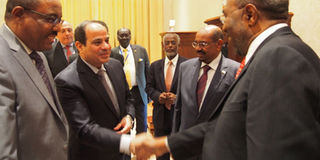Making peace through a dam on the world’s longest river

Prime Minister Dr Ruhakana Rugunda (right) greets Egyptian President Abdel Fattah el-Sisi, while Sudanese President Omar al-Bashir (second right) and Ethiopian Prime Minister Hailemariam Desalegn (left) look on. PMPU PHOTO
What you need to know:
River Nile has been glorified for decades, and if you have seen its white waters gush over rocks and meander through different vegetation, it is easy to see why. It turns out that the river also has a diplomatic advantage, writes Julius Mucunguzi
Our Paper Two Geography teacher at Kigezi High School in the late 1990s, the late John Birihanze, once told us that the Third World War would most likely be fought over conflicts about access to water.
Most of us in that class of “World Problems and Development”, laughed it off. In our small world, and largely from Kigezi region for that matter, we could not see how people could fight over water, of all things.
In Kigezi, nearly every valley has a stream. While it may be a tedious task to carry water to the mountain tops, still, the idea that people could fight over water, let alone start a war between and among countries, sounded so far- fetched.
Water, a scarce commodity for some
As we grew older and with our horizons expanding, it started becoming clearer how water is such a scarce commodity for many people around the world—and that a war over it was not far-fetched after all. We got to learn, for example, that for countries such as Egypt, Sudan and Ethiopia, access to the waters of River Nile is a matter of life and death. That these countries could do anything to safeguard the amount of water that flows into their territories.
But nothing had prepared me for the gravity of the need to harmonise and agree on how to use the waters from River Nile, than the move by Ethiopia to construct a mega dam along the Nile River.
Launched by Ethiopia in 2011, by the then prime minister Meles Zenawi, the Grand Ethiopian Renaissance Dam, is set to be African’s largest dam, producing 6,000 megawatts of electricity.
For Ethiopia, building this dam was a major drive to produce the much needed energy to drive industrialisation of the country.
But for other countries in the Nile Basin, particularly Egypt, there was cause for worry. The project was viewed in Cairo as a step that would reduce the amount of water available to them for irrigation, domestic, industrial, and other uses.
Solutions
For the years that followed, there was serious bickering between the two countries over the construction of the dam that it had to take several meetings to reconcile the interests of all parties involved.
One such meeting took place on March 23, when the leaders of Ethiopia, Sudan and Egyptian met in Khartoum to sign an agreement to let the construction of the dam get completed. To buttress the agreement, other countries that share the Nile Basin were invited.
For Uganda, Prime Minister Ruhakana Rugunda represented President Yoweri Museveni to witness the signing ceremony.
“It was a historic, and an emotional moment, seeing the three leaders’ hand-in-hand, putting signatures to paper on that agreement of cooperation,” Dr Rugunda said after the ceremony that took place at the Presidential Palace in Khartoum.
He added: “Uganda is pleased that the utilisation of the waters of River Nile, which sometimes has been a cause of conflict, has now, through this agreement, become a source of cooperation. Cooperation among the countries that share the basin of River Nile is the only sure way of deriving mutual benefits to drive development in our countries and improve the livelihoods of our citizens.”
He said President Museveni had been following, with keen interest, the negotiations among the three countries and is happy that they have come to a productive end.
Speaking at the signing ceremony, Ethiopian Prime Minister Hailemariam Desalegn said:
“I confirm the construction of the Renaissance Dam will not cause any damage to our three states and especially to the Egyptian people.”
Egypt, which relies heavily on river Nile waters for domestic, industrial and agriculture feared that the Grand Renaissance dam would reduce its water supply.
Egyptian President Abdel Fattah al-Sisi said: “This is a framework agreement and it will be completed. We have chosen cooperation, and to trust one another for the sake of development.”
Sudan’s President, Omar al-Bashir, hailed the deal and expressed his country’s commitment to cooperation with countries of the Nile Basin to reach plausible agreements.
“By signing this agreement, we confirm our commitment to pursue further detailed agreements that organise relations among the Nile Basin countries,” said Al-Bashir.
Witnessing what we did in Khartoum left no doubt in my mind at all, that my teacher John Birihanze, was right, after all.
Resource Diplomacy
In a place with shared resources such as water bodies, minerals and resources, there is bound to be a level of conflict among countries involved. This is when environmental diplomacy comes in. It usually includes the following:
• Using the environment as an initial entry point for dialogue between stakeholders within the context of a larger resource dispute.
• Facilitating technical solutions for developing a common information base for the parties to populate.
• Conducting independent technical assessments based on state-of-the-art science to equalize information between the parties and establish a roadmap for action.
• Brokering technical meetings, providing a neutral platform for dialogue, and supporting stakeholder consultation.
• Providing comparative examples of solutions that reflect good practice elsewhere or assisting in the analysis of scenarios or alternative solutions.
• Building capacity and catalysing resources for the implementation, monitoring, and validation of action plans and projects by the parties.




